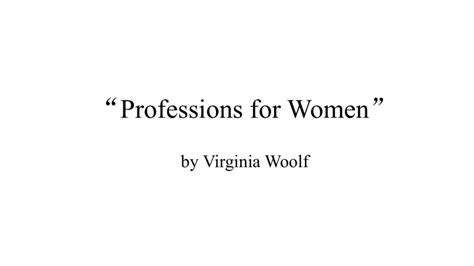Virginia Woolf, a literary icon of the 20th century, penned profound insights into the societal and professional constraints faced by women during her time. Her seminal work, “A Room of One’s Own,” painted a vivid picture of the challenges and aspirations of women seeking independence and fulfillment in a world often dominated by men.

Woolf’s observations remain relevant today, as women continue to navigate a landscape where gender disparities persist. Her incisive analysis and powerful advocacy for women’s rights inspire us to examine professions for women in a 21st-century context.
The Gender Pay Gap and Occupational Segregation
According to the Pew Research Center, women in the United States earn only 83 cents for every dollar earned by men. This gender pay gap is particularly pronounced in certain professions, such as finance, technology, and engineering.
Furthermore, women are disproportionately represented in lower-paying occupational sectors, such as healthcare, education, and social work. This occupational segregation limits women’s opportunities for career advancement and financial security.
Barriers to Women in Leadership and Higher Education
Glass ceilings continue to impede women’s progress in leadership roles. Despite evidence of women’s competence and qualifications, they are often underrepresented in executive positions. For example, in 2022, only 8.1% of Fortune 500 CEOs were women.
Moreover, women face persistent barriers in pursuing higher education, particularly in STEM (science, technology, engineering, and mathematics) fields. Gender stereotypes and a lack of female role models discourage many girls and women from considering careers in these areas.
Breaking Down Barriers: Empowering Women in Professions
Addressing the challenges faced by women in professions requires a multifaceted approach that includes:
- Increasing access to education: Providing women with equal opportunities for STEM education and leadership training.
- Challenging gender stereotypes: Dispelling traditional notions of appropriate careers for women and encouraging girls to pursue their passions.
- Promoting flexible work arrangements: Allowing women to balance their careers with their family responsibilities.
- Encouraging mentorship and networking: Connecting women with mentors and role models to provide support and guidance.
Inspiring Examples of Trailblazing Women
Throughout history, countless women have defied societal norms and broken down barriers in various professions. Here are some inspiring examples:
- Marie Curie: A Polish-French chemist and physicist who became the first woman to win a Nobel Prize.
- Ruth Bader Ginsburg: An American lawyer and Supreme Court Justice who championed gender equality.
- Margaret Thatcher: The first female Prime Minister of the United Kingdom.
- Malala Yousafzai: A Pakistani activist who advocated for the education of girls.
Building a Future of Equitable Opportunities
By recognizing and addressing the challenges faced by women in professions, we can create a more equitable and inclusive society. A world where all women have the opportunity to pursue their ambitions and achieve their full potential will benefit not only women but also society as a whole.
Let us draw inspiration from the legacy of Virginia Woolf and work together to build a future where women are empowered in all aspects of life, including their professions.
